Creative Pragmatism at Work: Generational Small Businesses in Baton Rouge
By Douglas Manger
Writings on occupational folklore examine the informal expressive behavior of workers on the job. Subtle or overt, dress, tricks of the trade, rituals, slang, jokes, nicknames, storytelling are all examples of expressive behavior—personalized with one's own stamp to be sure—used as modes of communication with others in the workgroup.
This essay takes a different approach, however. The focus here is on the expressive behavior of individual workers, not their interaction necessarily with others in the larger workgroup. Multigenerational or longstanding business owners in the greater Baton Rouge area are the field of exploration. Here we examine the extent to which personal expressive behavior has played a role in the success of eight Capitol Region business owners. As their comments illustrate, once these workers are presented with a challenge their creative impulses kick into in high gear, then seldom let go. Paradoxically, though true keepers of tradition on the one hand bound to the wisdom of pragmatic thinking, they are also to a person independent "outside the box" creative thinkers pushing at the boundaries to reach their goals in the business world.
The study begins with taxidermist Sonny Amato. When challenged by his brother to mount a duck, lack of experience didn't deter Amato at all. After creating a work space in the shed behind his parent's house he began to teach himself the trade. Over forty years later Amato is still at it as busy as ever. Eugene Brown, Sr., is a master clothier. He was inspired in youth by his mother who introduced him to fine clothing, and an extended family that placed no limitations on what he could accomplish. Perseverance in his career as a clothier has paid off giving Brown the creative freedom he so relishes. Still barbering in his late 70s, King Davis is owner/operator of Baton Rouge's iconic Webb's Barbershop. In continuous operation since 1924 Webb's crew of barbers, gifted cutters and talkers, alike, with their non-stop banter, keep customers coming through the door. Favaro's Rod and Reel Repair Shop opened in the 1940s. Owner Bill Favaro takes every defective reel that comes through the door to heart as a personal challenge. With Favaro's years of expertise in the offering, mixed with the appeal of a circa 1930s building, the shop remains one of the city's most enduring family businesses. Hall Davis, IV's, father taught him how to look fear in the eye. A practicing mortician for forty years Davis continues his family's tradition of entrepreneurial risk-taking. Davis is the owner of three funeral homes, the largest of which is located in northwest Baton Rouge. Al Lorio is a custom wood signmaker. In business since 1976 Lorio's work has been prominent throughout the city for decades. A steadfast survivor Lorio is decidedly old school preferring to render his designs by hand. A search for true expression took Michael Mattison down another path. First exposed to piano tuning while in Bible college, after serving some years in the ministry Mattison left to take up piano tuning full-time. With ever a desire to assume new challenges Mattison has now moved into piano restoration work, as well.
To a person all are creative out of the box thinkers and doers whose personal expressive modes of behavior have brought about a business ecology in the Capitol Region flavored with its own homegrown occupational folk culture.
Sonny Amato
Artistry of Wildlife by Sonny
In Sonny Amato's world of taxidermy advances in the field have resulted in significant changes in the way skill sets in the profession are acquired, and how and to what extent personal expression is exercised in the work.
As a youth growing up in north Baton Rouge, Amato neither hunted nor fished. Notwithstanding a career in taxidermy the same holds true to this day. Yet when approached by his brother early on to mount his harvested duck Amato took to the challenge with a level of ambition quite unexpected.
With no contacts in the profession to reach out to, Amato found what little information he could on the how-to's of taxidermy at the local library, then set to work in earnest learning on his own. "I'm a very determined person to do something if I have a mind to do so," Amato remarked. A small shed building in back of his parent's house became his workshop. And later, with their blessings, the family living room became his studio. To hone his skills Amato's brothers brought a steady supply of harvested birds back from their hunting trips for him to practice on. Without their help, Amato readily admits, he would not have been able to carry on.
By the time Amato finished high school his taxidermy business was up and running complete with a listing in the Yellow Pages. Right from the outset, with his brother's connections to well-heeled hunters in the area, Amato benefited from a steady stream of referrals. These upper class clients helped him establish his business. "They were more than willing to help me get along," Amato shared.

Given the freedom to take risks and to create on his own, Amato poured his heart into the work. "Well, number one, I always liked working with my hands doing things. Woodcraft, sculpture, just anything that had to do with my hands. And, then, like I said, I'm very determined person to do something. Once I get started on it I don't let go 'til it's right." When setbacks arose Amato's will power along with dogged determination kicked in to carry the day.
In earlier days old school taxidermists had no forms to work with. That meant spending considerable time creating an armature to support the specimen. These days taxidermists simply pick out the type of form they need from a sales catalogue. Typically made of foam or plastic, forms are available in countless poses for virtually any type of wildlife. In former days it was difficult for a taxidermist to recoup his time-in. All that changed when the molded forms were introduced. "Love of doing it is what kept me there and in the long run it paid off." As for the difference between old school taxidermy work and new school, Amato smiled, "[there is] not going to be nowhere near the comparison."
From a time of few if any how-to resources, the ever-growing popularity of taxidermy has brought forth an abundance of instructional materials. From books to training videos, information that was once jealously guarded is now readily available to aspiring taxidermists. "It's a lot easier now. I mean they got videos of how to mount deer, how to mount fish, how to do this. It's all broken down and people that have worked hard throughout their life, learning self-taught—most of them—how to do it, and now they've got video for the younger people coming on." Amato certainly does his part encouraging communication in the field. Over 1000 taxidermists nationwide are currently listed as "Friends" on Amato's "Taxidermists Helping Taxidermists" Facebook page.
Amato's expressive behavior comes into play when he is creating "something back to nature; to make it so real that if you touch a duck, it wants fly off." That's the hook for Amato. "Getting that live look to it. That's my passion."
Amato achieves his results by referencing to source materials like photographs or drawings. From that point on it's all in the application of skill sets refined over the past fifty years. Adding just the right coloration as needed, rendering the eyes with a certain look, positioning the specimen to bring out its true character. All are affects that make Amato's work his and his alone.
When asked to consider the spiritual nature of his work, Amato's reply was telling: "I'm a Christian, and I believe in the Lord. And the Lord has given me this gift to do this; and I try to please him, and myself, also. That's why I use reference to put it back, back to the way he created it."
When a trophy mount is finished the pay-off for Amato has little to do with the hours invested in the work or the payment received. Rather it's all about the praise he receives from the client for a job well done. "That wonder and awe mixed with appreciation from the client. . . . You can't go to the store and buy a steak with that," Amato declared. "That's something that goes to your heart. . . . It makes you feel good. . . . That all that work you've done, and everything that's involved in that particular piece, is well appreciated."
"I've got something here that very few people have. It's a hobby, a business, and a passion all in one. And, I love going to work every day. How many people have that? There's not very many people that can say that. . . . Me, I'm ready 'cause I have planned what I got to do the next day and I can't wait to get into it."
Eugene Brown, Sr.
Brown and Brown Master Clothiers
The making of Eugene Brown's mien (demeanor) had its beginnings in Savannah, Georgia. HIs father, a plumber by trade, died early in life. Had he lived a full life Brown is certain he, too, would have been a plumber. As it was, with the support of a strong loving family, Brown's career aspirations would take him in a decidedly different direction. "It was a special time. I was very fortunate in my upbringing," Brown observed. "When they talk about a community raising a child, that was especially true back then."
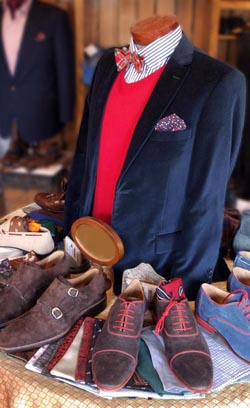
"I've always had a passion for clothing," Brown noted, "even in my younger years." During his formative years, as a ritual of sorts, his mother would take him to the better clothing stores downtown to buy his suits for church. This early exposure helped foster Brown's interest in fine clothing.
When he was older Brown began setting aside his earnings from summer jobs to purchase tailor-made shirts for back to school wear. "It was the way we pretty much did things. It was not elite, but certainly everyone didn't do it. . . . There was nothing special about me. . . . I had a number of friends, I mean, that's what we did." The attraction for Brown was that "[he] was able to go and pick out exactly what [he] liked and get it made the way [he] wanted to get it made. "Like I said," he continued "that's what we did. It was kind of the folkway of where we grew up within our culture."
During his years in school, Brown met his share of teachers who wouldn't take "no" for an answer. Ironically, as he pointed out, with in-state colleges and universities segregated at the time many aspiring teachers of color in Georgia attended top tier colleges and universities out of state with financial support from the State of Georgia. The rigors of his schooling helped shape an ambitious young Mr. Brown with a bent for risk taking, a trait more suited to the business world than to the classroom. After graduating from college, and a year and a half spent teaching, Brown assumed a full-time position with the men's clothing store he had worked for on the side. The move was a life changer to be sure. Through "the grace of God first. OK. Grace and favor," Brown declared. "Secondly, in my family you were just taught to think outside the box."
It didn't take long for Brown to make impressions on the job. With store locations in Historically Black Colleges and University (HBCU) communities, Baton Rouge, home to Southern University, was on his employer's radar. In a dream come true Brown was tapped to open a new Fashions Limited branch store in downtown Baton Rouge. At the young age of 23 the success of the new store fell squarely on Brown's shoulders. The year was 1973.
In looking back Brown spoke with pride about the practical education he received in the clothing business, a hybrid approach that combined first-hand experience, trial and error, and some teachings. "I got an education in the clothing business that I could not have gotten at any formal institution in the United States," Brown remarked.
Not one to let opportunity linger, four years after Brown opened the Fashions Limited location, he purchased the store outright. No longer regional in scope his new Fashions Limited store catered to local tastes. More change was to come, however. When the large retail stores in the city began selling both men's and women's clothing, Brown made another bold move. Out went Fashions Limited, in came a new start-up, Brown and Brown Custom Clothiers. His new business would offer custom-tailored clothing at an affordable price, a marketing niche relatively unexploited in Baton Rouge.
Since their founding, by offering consistent quality services across the board, the business in Brown's words has become "an integral part of family life in the community." Fathers, sons, and even grandsons spanning some three generations are valued customers. For many established families in Baton Rouge, be it a marriage, anniversary, or funeral, fine tailored clothing from Brown and Brown is viewed as a necessity to further exalt these rituals.
From those early custom shirt fittings by an Eastern European tailor in Savannah, Georgia, all has led to Brown's gift at creating the special look his customers are seeking. A master clothier to be sure reating elegrant dress for his clients appropriate in Baton Rouge society for all occasions. Elegantly patterned suits in assorted shapes, cuts, and colors; fine-weave dress shirts striped, checked, or plain with the owner's initials embroidered on the cuff in fanciful script; and, finally, a color coordinated tie to match looped around the neck then pulled tight to the collar with a "Windsor" knot.
We are "about people and where they are in life and what they are doing, because their clothing has to fit that." Brown remarked. "When a garment goes out the door you always want to put your best foot forward," he added. In the end it is Brown's hope that admirers will say, "I bet that came from Brown and Brown."
Brown reflected on the future of the business:
“It's something for me to be able to pass on something to my son or to have something that is really larger than the both of us. We are building something that will hopefully continue on and we'll be able to pass on for generations. It was both important and special to me to have [my son, Eugene] be a part of this.”
King Davis
Webb's Barbershop
Ask anyone in Baton Rouge where the best go-to place is for a Philly Fade haircut and Webb's Barbershop is sure to be high on their list. Located on the corner of Government Street and Eddie Robinson Sr. Drive, just east of downtown, the barbershop has been in continuous operation since 1924.
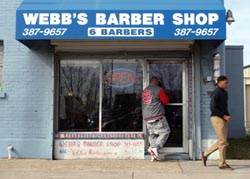
King Davis, the owner of Webb's Barbershop, left Louisiana at the age of 16 to attend barber school in Houston. His stepfather was a barber and wanted his stepson to be one, too. After all, they "made pretty good change." After his return from Houston, Davis eventually found work in his stepfather's Baton Rouge barbershop. He has barbered there ever since. Now approaching 80 years of age with some 50 years of barbering behind him, Davis continues to cut hair in the fifth chair back at the rear of the shop. Known as the "5-minute man," he still attends to his customers, many now advanced in years and balding.
Davis's speech is marked by colorful turns of phrase. His patter has a certain earthy feel to it. The husky bass voice adds to its character. After years of lively barbershop banter, Davis's delivery—with its ever so subtle syncopation—is practiced to be sure. Consider his take on why he prefers not to spend money on advertising for his business:
“We don't have to put no advertising like you do on for pay for advertising or nothing. . . . We don't need that. We got from mouth-to-mouth. You get your haircut at the shop, the next man say, "Where you got it to?" "You got it at Webb's." Then he tell the next man right on down the line. And we've been doing that for a long time.”
At Webb's Barbershop the constant ribbing between barbers and customers, alike, is all there for the witnessing. Such banter is practiced as a virtual art form in the shop with one barber trying to outdo the other. Davis admits customers come to Webb's in part for a haircut, in part to be “messed with.” Regulars know the drill. "Well, it kinda like, if you come in there you know you got to say something, so he gets his act up together before he come in there, because he got to come there ready," Davis explained. Be it a good joke, or a rousing argument, it's part of the ritual in the shop to keep the atmosphere lively, especially for the younger barbers. "Oh, no, they talk all day." Davis laughed, "Man, you need a movie camera to catch all them cats be talking. They talk and joke. . . . My little 'nep,' he don't quit running his mouth. They talk all day. Everybody come in. They don't pick who to talk. They mess with everybody, . . . That's what they [the customers] come there for. They don't mind. They joke with you, you joke with them." If the customer keeps his mouth shut, Davis added, barbers and waiting customers alike "make you want to say something."
Pranks are another form of personal expression in the shop. Davis shared one of his stepfather's favorites: At times when one of his barbers fell asleep in his chair he'd place a dollop of shaving cream in their hand, then tap them on the forehead. Up came the hand with the shaving cream, smack on the forehead!
Apart from the banter and pranks along the way, certain rituals still hold true. In day's past Davis wore a dress shirt with a necktie under his smock. Today barbers in the shop wear open neck shirts or white t-shirts. The tail of the t-shirt can't be worn out, however, if it's longer than the smock. The shop's three shoeshine men are now long gone, their stand replaced with a Coke machine. The shoeshine trade is going out, Davis observed. "Only pair of shoes he rub 'em on himself to go to church with."
According to Davis haircut styles change every 6 to 8 months. Regardless, examples of popular traditional cuts can be referenced on style charts hung on the wall. "Oh man, they change styles like they change shoes," Davis remarked. One of his younger customers wanted a different cut every time he came in! White football players, some from LSU and others from Southern University, visit Webb's to get their Philly Fade or Ball Fade haircuts. No cursing or acting out is allowed in the shop. If you act crazy in the shop, Davis will put you out. As for his personal protocol, Davis smiled, "If you move, I don't cut."
The longevity of the staff at Webb's is remarkable. Louis Tillotson, the barber who cuts hair next to Davis in chair #4, has worked in the shop for over 40 years. His son works chair #1. With just shy of 20 years cutting hair at the shop he remains the junior member on staff. Davis's two nephews—his brother's two sons—work the second and third chairs. Each barber is responsible for paying rent on his chair. Each barber is also responsible for purchasing his own clippers, scissors, and other accessories needed on the job. As for the customers the barbershop operates strictly on a first-come first-serve basis. Most of the established customers who visit the shop favor a particular barber's style. When the shop is really busy, Davis pointed out, anywhere from 8-10 customers may be waiting in line for their favorite barber, seated in a chair or perched on the window ledge outside.
How much longer Davis will continue barbering is uncertain. When he does retire Webb's Barbershop tradition is sure to live on as plans are in place for Davis's older nephew to take on the business.
Bill & Sam Favaro
Favaro's Rod & Reel Repair Shop
In the 1940s, when Favaro's Rod and Reel Repair Shop came into being, Weller Avenue in northwest Baton Rouge was a far different place. A mix of family-owned businesses were spotted along the avenue. At one end stood the neighborhood cinema, the Avenue Theater. All of the small business owners along the avenue were friends, if not direct relatives. "They all worked together," Hypolite "Sam" Favaro remarked. The ethnic mix included French and Italian Americans with names like Hebert and Repola. Majority Catholic, most attended the same church.
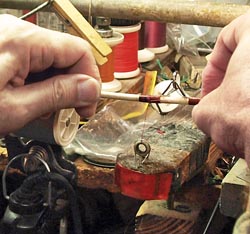
In the 1940s, open woods lay beyond the avenue. A mile or so away, where St. Gerard Majella Catholic Church now stands, deer hunting was a popular pursuit. With unpaved streets there were some shortcomings, however. When Favaro visited his aunt around the corner his mother warned him not to beat the pillows for fear of raising too much dust.
Favaro's started out as a general merchandise store, part of a chain called Pleasing Food Stores. The goods sold at the store ranged from food, to paint, to nylons. Although the store prospered for a time, when national grocery stores began opening up branches in Baton Rouge, "Bill" Favaro's father decided to make a change. An avid fisherman, repairing rods and reels seemed an obvious choice. "[My daddy] just developed from that," Favaro explained. "He was doing it as a hobby to start off with and it just developed into a business." Years later after his return from military service in Vietnam, Favaro took over his father's business.
Today Bill Favaro—a master at the repair and renewal of rod and reels—follows in his father's footsteps. His customers today include second, third, even fourth generation family members. With the relaxed atmosphere—wooden floors underfoot, a pressed tin ceiling overhead, customer photos of the big catch on the wall—the period look of the shop is a real drawing card. "White, Black, whatever, they keep coming back," Sam Favaro remarked.
Despite the veritable forest of fishing poles awaiting repair and the reels laying in assorted pieces on the work tables, Bill Favaro still manages to maintain an air of calm. Most of the activity in the shop revolves around the repair work although fishing supplies are for sale at the front of the store. Favaro's special skill, and that of his helper, Jeffrey, lies in their abilities to take any rod or reel they are presented with and make it right again. With fishing reels that assumes an almost encyclopedic knowledge of various models—from the vintage Ambassadeur, Pflueger, and Shakespeare spinning reels of yesteryear, to the high end Calcutta, Kaleigh, and Stella spinning reels of today. "The reels, you know, is like a puzzle. . . . You got and try to figure out, what's wrong with them," Favaro commented. With the many styles of reels available on the market today, he added, "you have to keep a diagram with each reel that comes in."
With his years of experience Favaro can often gauge what the problem is as soon as he sees the reel the customer has in hand. Modern reels are low-profile. They must be taken completely apart to determine the issue. For Favaro that means spending an hour to an hour and a half on the repair. In contrast, with a vintage Ambassadeur reel with all the component parts exposed, the repair may be possible with the needed replacement part(s) in five minutes time.
As for the forest of fishing rods in the shop, many await new tips, new guides—or in the case of rods that have broken—a thorough splicing. The latest style "micro rods" fitted with the smallest of guides are among them. "If an angler uses too thick a line on these rods," Favaro cautioned, "the rings [guides] may pop."
In Sam Favaro's view the pay-off for his brother—and helper, Jeffery Westmoreland—is "the pleasure the work brings to them" and doing the job right without "ripping the customer off." Bill Favaro offered his own take. After repairing a Red Ambassadeur spinning reel the owner caught a record-breaking 15 pound bass. "Like to think we had something to do with it," Favaro remarked in a soft voice.
Hall Davis IV
Hall Davis & Son Funeral Services
As "the caregivers of what God created" mortician/funeral director Hall Davis, IV, and company are held to a strict code of ethics. Most day-to-day business matters at Hall Davis and Son Funeral Services pertaining to burial protocols are strictly governed by law. In that regard, personal expression for Davis is found elsewhere, mainly in devising new ways to expand his business. This is where his flair and creativity truly comes to the fore. With Davis's preference for working on the cutting edge much of the occupational lore surrounding his exploits understandably is yet to emerge awaiting the synchronicity between the 'out there' and 'the here and now' where most of us reside.
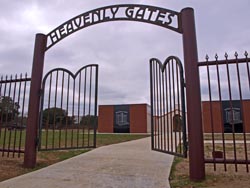
In West Baton Rouge Parish where he grew up, Davis explained, every plantation had a church for those who lived and worked there, with a cemetery as well. Given the proximity of the Mississippi River over time the destructive effect of the water table on grave sites was telling. The same held true for Baton Rouge on the east side of the river. Even today, he added, "in many cases water must be pumped out before they put the vault in the grave."
Determined to address the situation Davis researched the burial tradition in New Orleans. With the city below sea level above ground mausoleum crypt burials are the norm. There is a "whole lot more dignity to a mausoleum," he offered. "High, dry, revisit-able," Davis is left with the feeling that all has been done properly. In contrast when burying someone in the ground, "I don't leave there 100%," he explained.
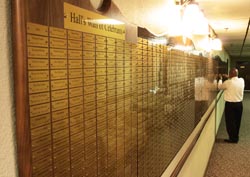
Convinced that the mausoleum burial approach needed to be adopted in Baton Rouge, Davis sprang into action. Enter his newly opened Heavenly Gates Garden Mausoleum complex in Baton Rouge situated on two acres of land adjacent to the airport. When fully completed the complex will house 20 stand-alone mausoleums each equipped with 220 burial niches. Head-to-foot "Companions," side-by-side "True Companions," "Singles," and niches for "Cremains" are burial options available to prospective clients. (Davis pointed out that cremation is not a practice among African Americans. However, in other ethnic groups combined, statistics now show the figure soaring upwards of 50%.) To address an ever-growing population the Heavenly Gates Garden Mausoleum complex also features niches for oversize persons. As for the price structure, Davis explained, it varies according to the height of the crypt.
Bringing his new mausoleum complex into reality has challenged Davis's creativity, range of vision, and depth of thought at every turn. To take matters one step further, Davis now envisions selling some of his stand-alone mausoleums to area churches. "For years and years churches had cemeteries of their own," he explained. "Here's an opportunity for you to have a cemetery of your own in my cemetery. If you buy it, I'll put the picture and the name of your church on that building." Selling stand alone mausoleums to churches in Davis's view is a form of community building; a way of counteracting "everything that tends to divide us." If ten churches buy into the concept," Davis explained, "they could have one big function there to commemorate the ones that's buried there. . . . That could be an awesome bringing of community back together." Thinking outside the box in his charismatic fashion, future plans for the complex may well include burial crypts configured inside the chapels. Davis confided, "What I'm also trying to do is reestablish the true meaning of a dignified funeral."
Davis's great grandfather was born in 1876. His son, Hall Davis, II, had his own business delivering ice in Plaquemine. With the advent of refrigeration, he switched occupations renting out his car as a limousine service. Hall Davis, III, after graduating from mortuary school in 1949, worked at Gilbert's Funeral Home in Baton Rouge until 1954. At that point he and his wife opened up a funeral home of their own in Port Allen. Last year, 2014, marked the location's 60th anniversary.
The Port Allen facility functioned as both a funeral home and the Davis family residence. Hall Davis, IV's, bedroom at the time was but 15 feet away from the morgue. From 12 years of age on, young Hall Davis was called upon at all hours to accompany the funeral home's ambulance drivers (another spin-off business). "I was a pretty big boy. I could pick up [someone injured, or a dead body]." Davis got up, got out, and learned. This helped him overcome his fears. "If you traveled with Daddy," Davis shared, "he was the kind of individual who had no fear of anything."
Hall Davis, IV, would later attend Commonwealth Institute of Funeral Service in Houston. After graduating in 1975 he returned home to work at his father's funeral home in Port Allen. In 2005 he branched off opening his own facility in north Baton Rouge. Today he maintains two other satellite facilities: the family's original funeral home in Port Allen and a facility in Plaquemine. As a state certified mortician Davis holds licenses as both a funeral director and embalmer.
"We as a family run this business," Davis commented. His wife, daughter, and son are all part of the operation. Now with over 40 years in the profession, Hall Davis, IV, continues to uphold the family tradition of entrepreneurship. "We take great pride in that. . . . My whole thing is just building the business for the next generation."
Al Lorio, custom wooden signs
Lorio Design
Doodling and drawing is how it all started. That was Lorio's creative outlet as a teenager and in a fashion it remains so to this day. At his south Baton Rouge location he continues to render his commercial signs the old school way, mostly by hand.
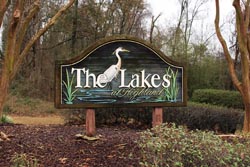
Al Lorio is of mixed French and Italian ancestry. Although the name Lorio sounds Italian, as he pointed out, it's actually French in origin. A native of Baton Rouge, he and his sister as well as his parents attended Baton Rouge public schools.
By his senior year of high school Lorio had become the school's de facto student artist called upon to paint the bulldog mascot wherever needed. There were benefits, of course. It was his ticket to get out of class. "That's how it all started, drawing bulldogs," he commented. After high school and a few college level art classes, "[I] sort of evolved into the sign business one sign at a time." If someone needed a sign, Lorio jumped right in. His learning curve was mostly trial and error until he hired on with Lamar Sign Company. In that era, all of the 14' x 48' highway signboards were rendered by hand with the pattern first enlarged on the plywood, roughed in with charcoal, and then hand-painted. The skill sets required in his work at Lamar Sign Company matched Lorio's perfectly. "That was my trade and that is my trade," Lorio stated matter-of-factly.
After some five years in the trade, as Lorio recalled, a totally different type of sign appeared on the scene in Baton Rouge for the first time. When a sample turned up in the shop where he was working, "I mean, it changed my life. . . . Oh my God, that's what I've got to do. . . . I'm going to do that for the rest of my life. . . . Everybody was blown away by them things." Moving away from his work hand-lettering signs, Lorio did just that by opening up his own sign making business. The year was 1976. He would specialize in carved redwood signs—just like those recently introduced in Baton Rouge—sandblasted to give them an unusual textured look. With few vendors in the area producing signs of this type his timing could not have been better. As word spread about the wooden sign guy, business owners in the city began calling. Little did Lorio realize at the time, the demand for his hand-worked signs would carry his business for the next 20 years.
To be sure Lorio brought skill sets to the table that his competitors were hard pressed to match. For starters, without ever laying a hand to paper, he could design the sign in his head as the client was describing what they wanted. And once the work began Lorio could render fonts of his own design by sketching them out freehand. No computer generated designs for him. "At one time people would come just to watch me work," Lorio recalled, taken with his skill at creating fonts and fanciful designs from his own imagination.
If his clients are amenable, Lorio's approach with his sign making to this day remains decidedly old school with hand rendered patterns and pounce wheel transfers. (In terms of Lorio's approach, a burred pounce wheel is used to trace the pattern. The small holes in the paper left by the wheel are then pounced by rubbing chalk, charcoal, etc. over the design. When the paper overlay is removed, the design is revealed in outline form on the underlying surface.) Clear grade, all heart, vertical grain California Redwood was Lorio's material of choice for years. With redwood supplies limited, he now uses Spanish Cedar. Throughout Baton Rouge Lorio's custom wood signs with their elaborate raised lettering, swoops and swirls are evident everywhere; a testement to just how pervasive his business has been over time.
In time, however, change caught up with Lorio. "The technology is really. . . . It's just taken over. . . . Shot me in the foot," Lorio lamented. "It's great for everybody except an old school sign painter like myself. The technology is cool if you're using it, but it hurts me more than helps me." With no interest in conforming to the technology, his sign making niche, so assured in the past, remains vulnerable to the times. "I value my creativity more than others do," Lorio declared.
Approaching forty years day-in-day-out in the sign maker trade, the freedom to exercise his own vision has given Lorio's life its meaning. Now with continued advances in technology ironically there is less call for him to exercise his own vision. In more cases than not clients now approach Lorio with a design already in hand.
Some scholars would argue that this does not necessarily mean consumer tastes for Lorio's old school brand of craftsmanship are no more. The trends of time have proven many occupational folk genres to be far more enduring than otherwise expected. Contrary to his feeling that the sign business has outgrown Al Lorio, it is possible that his client base are merely exercising options that once explored will ultimately lead them back to the "wooden sign guy" where true originality carries the day.
Mike Mattison
Professional Piano Tuner
On the vast raised stage at the Jimmy Swaggart Ministries Family Worship Center in Baton Rouge sits a 9 foot 3 inch Austrian made Bösendorfer grand piano. Seated at the keyboard piano tuner Michael Mattison begins the exacting task of adjusting the temperament of the piano. With his tuning hammer at the ready he strikes a key at mid-point on the keyboard. AW440, or A4, with a frequency of 440 Hz, is the musical note A above middle C that serves as a general tuning standard for musical pitch. His electronic tuning device (ETD) comes alive. No need really, with his acute hearing Mattison is already aware of the discrepancy in sound. With a glance at the read-out to confirm his thinking he begins making adjusts with his tuning hammer. Once satisfied Mattison moves on to adjust the remaining keys by tuning octave intervals up and down the keyboard.
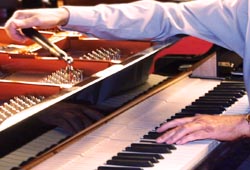
Grand pianos generally have 230 strings. The ten lowest notes on the keyboard have one string, the next 18 having two strings, while the remaining have three. Technically speaking, pure intervals when arranged on a keyboard result in octaves that aren't pure. As a consequence the so-called thirds, fourths and fifths do not perfectly coincide. In order to accommodate the Western scale it's necessary to compromise intervals to fit within the scale. This is what is called tempering. The result is a temperament.
After 40 years in the trade Mattison's pace is now more measured. "If I take two hours I can nail each tuning pin more solidly," he explains, "so it will stay in tune." To accomplish this Mattison takes the wire tension on each tuning pin above pitch, then eases it back down the pitch. "[The] tension of the wood trying to move the pin sharp, and the tension of the wire trying to pull it flat, comes to a counter balance. A state of equilibrium." At this critical balance point the tuning pin then becomes stable.
Mattison tunes his pianos with the aid of a small palm-sized electronic tuning device (ETD). The device, which functions like a computer, has a complete range of piano temperaments programmed into the software. With that function Mattison is able to program the model of piano he is working on into the ETD to arrive at the adjustments he needs. "We maybe tune 8 or 10 notes into the computer and the computer calculates [how] the rest of the piano [is to be tuned]." Although the ETD provides a visual readout more precise than the human ear, Mattison routinely goes back to make some final adjustments by ear; an indication of just how acute his hearing is. "So that's the art of the tuning process," Mattison remarked. "It's more than just making it sound right. My job is to make it sound right tomorrow, next week, and next month, after I've walked away from it. . . . That's the world I live in, the world of frequencies."
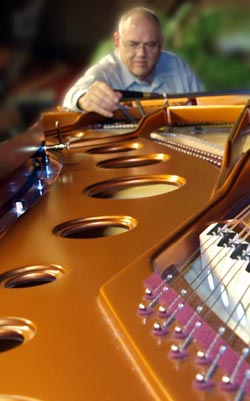
Mattison was reared near Springfield in Livingston Parish. His father was a preacher. With a wife and eight children to feed, when money was tight his father's carpentry skills often saved the day when money was tight. Once he finished high school Mattison left home to attend Bible college in northern Illinois, the same institution his father had attended many years prior. To help earn his way Mattison hired on part-time at the piano factory across the street from the college. At the time (mid-1960s) the Aolean American Company was the largest piano company in the world. Once on the job Mattison was trained to rough tune the pianos nearing the end of the production line, a process called chipping. "So we 'chipped' the pianos," Mattison explained, "that was what a rough tuning was called in the factory." His tools of the trade at the time were few in number: a homemade guitar pick, a tuning hammer, and a tuning fork. To spare his knee Mattison tapped his tuning fork on the edge of the piano bench. When he finally left the job a one inch deep hole on the piano bench remained where he had tapped his tuning fork all the while.
After completing Bible college Mattison entered the ministry. During his years in the pulpit he served churches in Mt. Pleasant, Michigan; Dallas, Texas; and later Baton Rouge. At each location Mattison tuned pianos on the side for extra income. "[It] dovetailed really well as a dual career situation," he explained. However, in time his situation would change. After ten years preaching in Baton Rouge, Mattison made the decision to take up piano tuning full time. Although his heart is still in pastoring, Mattison admits his skill sets are really in the piano tuning area. "I found I could put each note to the point of perfection and then let somebody else put them all together into music."
Mattison's work allows him to serve customers from all walks of life. "Piano tuning as a business is as much a people business as it is a technical business," he commented. "[My] clientele are very nice people, . . . I can trust my clients, they can trust me." It's not unusual for a client to leave Mattison alone in their home while he is tuning the piano. With a broad smile he added, "Never once have I stolen the silverware." From teachers to lawyers to refinery workers, his clients run the gamut. Mattison's ability to deal with people of differing attitudes, personalities, and ethnic backgrounds explains in no small measure his success in his trade.
That special expressive quality that Mattison offers to the world, one he truly revels in, lies in his ability to pick up on variations in pitch most listeners could never possibly discern. Mattison's face lit up, "It's fascinating to me that I get paid for adjusting things that people can't even see."
Sources
Amato, Sonny. 2015. Interview by author. February 11.
Brown, Sr., Eugene. 2015. Interview by author. February 3.
Davis, King, IV. 2015. Interview by author. January 28.
Favaro, Bill and Sam. 2015. Interview by author. January 15 and 27.
Lorio, Al. 2015. Interview by author. January 23.
Mattison, Michael. 2015. Interview by author. January 20.




























